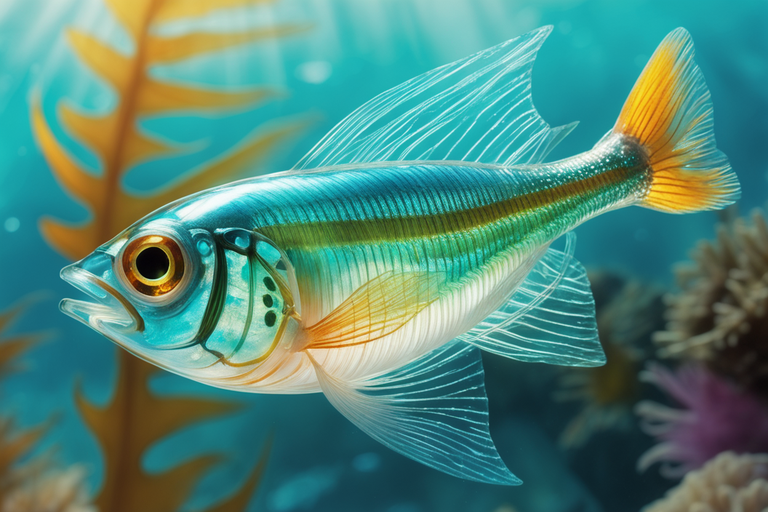Are you looking for a captivating addition to your aquarium? Look no further than the Indian Glassfish.
These dazzling creatures, found in the streams and rivers of India, boast a unique transparent body that adds an enchanting touch to any tank.
With their active and inquisitive nature, they are sure to captivate and entertain you.
In this article, we will delve into the habitat, physical appearance, behavior, and care requirements of these mesmerizing fish.
Get ready to dive into the world of Indian Glassfish!
Here are some quick facts about Indian glass fish:
- Indian glass fish (Parambassis ranga) is a fish species that is native to the mangrove swamps of India and Pakistan, as well as the freshwater marshes of Cambodia and Burma5.
- The glass fish has a tiny body that grows only up to 3.2 inches (8.1 cm) on average2.
- Males of the species develop a blackish or bluish tint on their dorsal fins, and they are a slightly deeper yellow on the body than females 3.
- Indian glass fish have transparent scales that enable seeing their innards and bones4.
- The name glass fish is also given to certain other unrelated, semitransparent fishes, including the icicle fish 6.
- Diet: Indian Glass Fish are omnivorous and will consume a range of foods, including flake foods, brine shrimp, and daphnia.
- Temperament: Generally peaceful, they are suitable for community tanks but should be kept with non-aggressive tankmates.
- Habitat: In the wild, they prefer slow-moving waters with dense vegetation. This preference should be replicated in aquariums for their well-being.
- Color Injections: Unfortunately, the Indian Glass Fish has been subject to a controversial practice of dye injection to make them appear more colorful for the pet trade. This process is harmful and reduces their lifespan.
- Breeding: They scatter their eggs among fine-leaved plants. After hatching, the fry becomes free-swimming in about four days.
- Lifespan: With proper care, the Indian Glass Fish can live up to 3 to 5 years in captivity.
- Water Conditions: Preferably, the water should be slightly acidic to neutral (pH 6.5 to 7.5) with moderate hardness.

Habitat and Distribution
You can find Indian glassfish in freshwater habitats throughout India and neighboring countries. These beautiful and delicate fish are native to the rivers, lakes, and ponds of the Indian subcontinent. They’re particularly abundant in the Ganges and Brahmaputra river basins. Indian glassfish have also been introduced to other parts of the world, including Southeast Asia, and can now be found in countries like Indonesia and Thailand.
In terms of conservation status, Indian glassfish are currently not listed as endangered or threatened. However, habitat destruction and pollution pose significant threats to their populations. As human activities continue to impact freshwater ecosystems, it’s crucial to monitor and protect the habitats where these fish reside.
Efforts should be made to raise awareness about the importance of conserving these species and implementing sustainable practices to ensure their long-term survival.
Physical Appearance
The physical appearance of this unique fish includes a transparent body and vibrant colors. Indian glassfish, scientifically known as Parambassis ranga, are small-sized fish that typically measure between 4 to 6 centimeters in length. They’ve a slender body with a slightly compressed shape, which allows them to swiftly maneuver through the water.
One of the most striking features of the Indian glassfish is its translucent body, which allows you to see its internal organs and skeleton. The color variations of this fish are truly remarkable, ranging from shades of silver, gold, and green to iridescent hues of blue and purple. These vibrant colors serve as a form of camouflage, helping them blend into their surroundings and avoid predators.
Despite their delicate appearance, Indian glassfish are hardy and adaptable, making them a popular choice for aquarium enthusiasts.

Behavior and Temperament
When observing their behavior, you’ll notice that these unique fish are peaceful and tend to swim in schools. Indian glassfish are known for their calm and non-aggressive nature, making them suitable for community aquariums. They rarely show any signs of aggression towards other fish, preferring to maintain a harmonious environment.
Here are some key points about their behavior and temperament:
- Indian glassfish are highly social creatures, thriving in the company of their own kind and other peaceful fish.
- They exhibit schooling behavior, meaning they prefer to swim closely together in a synchronized manner.
- These fish aren’t known for their territorial tendencies, making them less likely to engage in conflicts with tank mates.
- Although they’re generally well-behaved, Indian glassfish can benefit from training and obedience exercises to enhance their overall behavior and responsiveness.
Overall, Indian glassfish are gentle and cooperative fish that add tranquility to any aquarium setting.
Tank Setup and Maintenance
Creating a suitable environment for these fish involves setting up a well-maintained tank with appropriate filtration and regular water changes. Tank filtration is essential for maintaining water quality and keeping the Indian Glassfish healthy. A good filtration system helps remove waste, excess food, and toxins from the water, ensuring a clean and stable environment. It’s important to choose a filtration system that’s suitable for the size of the tank and can handle the bio-load of the fish.
Additionally, monitoring and maintaining the water parameters are crucial. Indian Glassfish prefer slightly acidic to neutral water with a pH range of 6.5 to 7.5. The water temperature should be kept between 75 to 80 degrees Fahrenheit.
Regular water changes of about 25% every 1 to 2 weeks are necessary to maintain optimal water conditions for these fish.
Feeding and Care
To keep your fish healthy and well-nourished, it’s important to provide a balanced diet consisting of high-quality fish food and occasional live or frozen treats. Indian glassfish are omnivorous, so their diet should include a variety of protein-rich foods such as bloodworms, daphnia, brine shrimp, and high-quality flakes or pellets.
Here is a suggested feeding schedule for your Indian glassfish:
- Feed them small amounts 2-3 times a day, but don’t overfeed as it can lead to health issues like obesity and poor water quality.
- Offer a mix of dry and live/frozen foods to provide a varied diet.
- Keep an eye on their appetite and adjust the amount of food accordingly.
- Remember to remove any uneaten food after a few minutes to maintain water quality.
It’s also important to be aware of potential health concerns such as fin rot, swim bladder disorder, and parasites. Regular observation and maintaining a clean and well-maintained tank will help prevent these issues.
Conclusion
In conclusion, the Indian glassfish is a fascinating species that requires specific care and attention in order to thrive in a home aquarium.
With its unique physical appearance and peaceful temperament, it can make a beautiful addition to any tank.
By providing the right habitat setup, maintaining proper water conditions, and offering a varied diet, owners can ensure the health and well-being of their Indian glassfish.
With the right care, these fish can bring joy and beauty to any aquarium.

